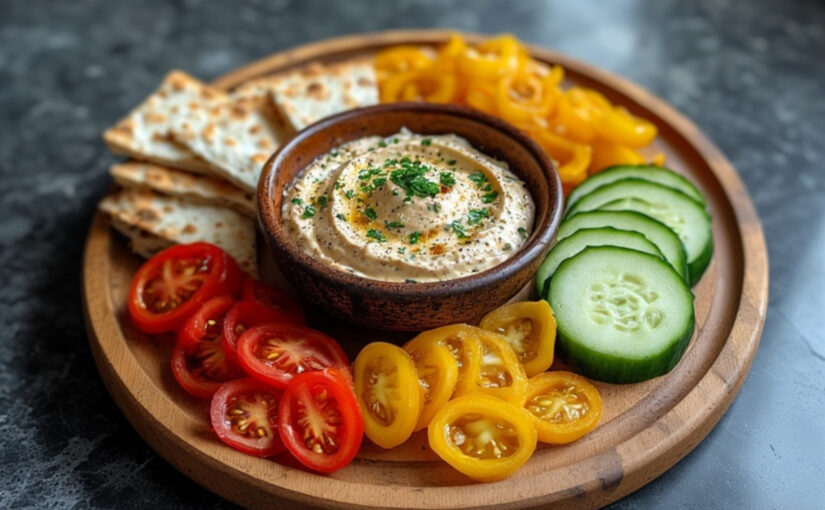Few dishes capture the essence of Mediterranean hospitality quite like a bowl of silky tarator. This traditional Turkish nut dip transforms humble ingredients into something extraordinary. Toasted nuts blend with bread, olive oil, and bright lemon into a velvety sauce that’s equally at home alongside grilled fish or scooped up with warm pita bread. 🍋✨
What makes tarator so beloved is its remarkable versatility and depth of flavor. Each spoonful delivers richness from the nuts, brightness from lemon, and a subtle warmth from garlic and cayenne. The texture is luxuriously smooth, yet the preparation couldn’t be simpler. Whether you’re hosting a meze party or seeking an elegant accompaniment to roasted vegetables, this dip delivers sophistication without fuss.
🏺 From Ancient Anatolia to Modern Tables
Tarator’s roots stretch deep into the culinary traditions of Anatolia, where resourceful cooks discovered that nuts, bread, and olive oil could create sauces of remarkable refinement. The name itself varies across regions. In Turkey, tarator typically refers to this nut-based creation, while similar preparations appear throughout the Balkans and Levant under different names.
The genius of tarator lies in its foundation of thickened bread paste, a technique that dates back centuries when cooks needed to create smooth, stable sauces without modern emulsifiers. Bread served as the binding agent, its starches helping nuts and oil merge into perfect harmony. Historical records suggest variations of this sauce accompanied everything from fried fish to boiled vegetables in Ottoman palace kitchens.
Different regions championed different nuts. Coastal areas favored hazelnuts gathered from Black Sea hillsides, while inland communities preferred walnuts from mountain groves. In prosperous households, pine nuts added luxury to special occasions. Each nut brought its own character. Hazelnuts contributed earthy sweetness, walnuts offered slightly bitter complexity, and almonds provided clean, delicate flavor.
The tradition of toasting nuts before grinding them wasn’t merely about intensifying flavor. It also helped release their natural oils, making them easier to blend into the signature creamy texture. This step transformed raw nuts into aromatic ingredients that could stand up to the assertive flavors of garlic and lemon.
Today, tarator remains a cornerstone of Turkish meze culture, that wonderful tradition of sharing small dishes with friends and family. It represents the Mediterranean philosophy of creating extraordinary experiences from simple, quality ingredients and generous hospitality. 🌿
📊 Recipe Details
Yield: About 1 cup (serves 4-6 as part of a meze spread)
Prep Time: 10 minutes
Cook Time: None (beyond toasting nuts)
Dietary: Vegetarian, can be made vegan
Speed: Fast! Ready in 15 minutes ⚡
🥘 Ingredients
For the Dip:
- 1 slice hearty white sandwich bread, crusts removed, torn into 1-inch pieces 🍞
- ¾ cup water, plus extra as needed 💧
- 1 cup blanched almonds, blanched hazelnuts, pine nuts, or walnuts, toasted 🌰
- ¼ cup extra-virgin olive oil 🫒
- 2 tablespoons lemon juice, plus extra as needed 🍋
- 1 small garlic clove, minced 🧄
- Salt and pepper to taste 🧂
- Pinch cayenne pepper 🌶️
👨🍳 Instructions
Step 1: Create the Bread Paste
Using a fork, mash the torn bread pieces and ¾ cup water together in a bowl until you have a smooth paste. This forms the creamy base that gives tarator its signature texture. 🥄
Step 2: Blend Until Silky
Add the bread mixture to your blender along with toasted nuts, olive oil, lemon juice, minced garlic, ½ teaspoon salt, ⅛ teaspoon pepper, and cayenne. Process for about 2 minutes until completely smooth and velvety. 🔄
Step 3: Adjust Consistency
Check the texture. The dip should be barely thicker than heavy cream. Add extra water, a tablespoon at a time, if needed to reach the perfect consistency. 💫
Step 4: Season and Rest
Taste and adjust seasoning with additional salt, pepper, and lemon juice as desired. Let the dip rest at room temperature for the flavors to meld beautifully. ⏰
🍽️ Serving Suggestions
Tarator shines as part of a meze spread alongside:
- Warm pita bread or Olive Oil-Sea Salt Pita Chips 🥖
- Fresh raw vegetables like cucumbers, carrots, and bell peppers 🥒
- Grilled or fried seafood, especially white fish or shrimp 🦐
- Roasted vegetables such as cauliflower or eggplant 🍆
- Falafel or other Mediterranean favorites 🧆
Serve at room temperature in a shallow bowl, drizzled with extra olive oil and garnished with a sprinkle of cayenne or fresh herbs. 🌿
💡 Pro Tips
Nut Selection: Each nut variety creates a unique flavor profile. Hazelnuts offer earthiness, almonds provide subtlety, walnuts bring depth, and pine nuts add buttery richness. Try them all! 🎯
Toasting is Essential: Don’t skip toasting the nuts. This step awakens their oils and creates complex, aromatic flavors that make the difference between good and exceptional tarator. 🔥
Make Ahead: This dip actually improves with time. Refrigerate for up to 2 days, then bring to room temperature before serving. The flavors deepen and marry beautifully overnight. ⏳
Consistency Matters: The sauce should flow smoothly but not be watery. Think slightly thicker than heavy cream for the ideal dipping consistency. 📏
Bread Choice: Use quality white sandwich bread with good structure. Avoid overly soft or sweet breads that might throw off the balance. 🍞
Enjoy this taste of Turkish tradition that brings warmth and sophistication to any gathering! 🎉
If our work has inspired you, helped you grow, or simply brought a little warmth to your day, consider supporting Thalysia.com with a small donation. Your contribution helps us continue exploring ancient landscapes, documenting local traditions, and celebrating the art of living well.
